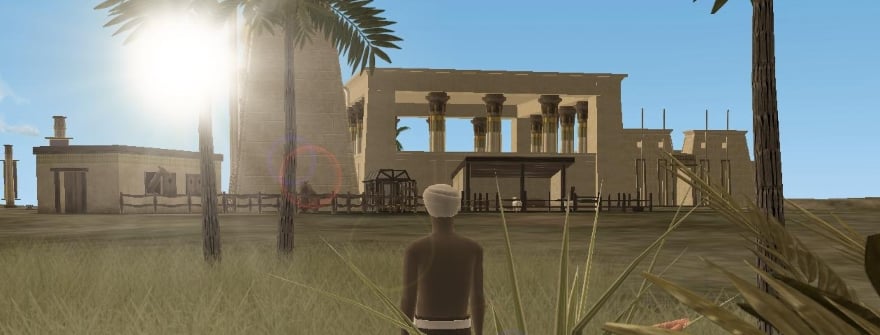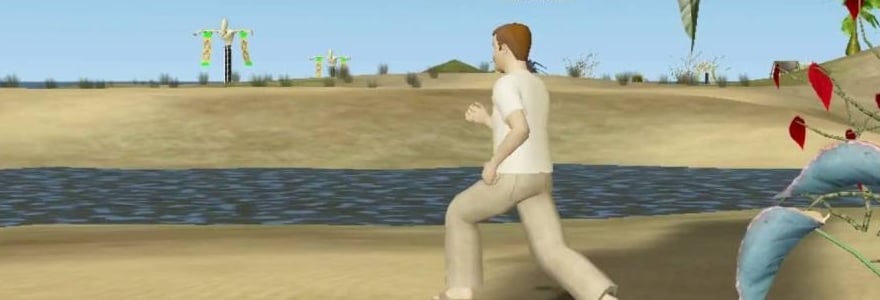
Once asked what he thought was the most innovative MMO from the last decade, Dr. Richard Bartle, the creator of MUD, gave a succinct answer: “A Tale in the Desert. Note that ‘innovative’ doesn’t necessarily mean ‘successful.'”
Right there is the crux of A Tale in the Desert’s unique position in the MMO industry. Instead of storming down a path well-traveled, it took a machete and made its own trail — a trail down which few have followed. It is an “odd duck” of a game, skewing as far away from combat as possible to focus instead on crafting and politics. Even though its focus pegged it as an eternally niche game, the MMO proved that constant fighting isn’t the only thing that can draw an online community together.

The peaceful struggle
When an MMO has no combat, won’t people get bored in a jiffy? Looking a the vast, vast majority of online RPGs out there, you’d think this would be the case — combat comes as a factory default setting in most games, along with snide-impact dirtbags and hot air conditioning. But if nothing else, A Tale in the Desert proves that there can be more than just fisticuffs and fireballs to MMOs.
Instead of fighting mobs-slash-loot piñatas, players were invited to shift their game worldview and focus on achievements, crafting and socializing instead. ATITD put players in the sandals of ancient Egyptians tasked with building a civilization from a virtual sandbox. Players chose to pursue a variety of disciplines — from architecture to harmony — and accomplish a series of tests that each required. The tests encouraged players not only to build a physical infrastructure for the world but to bond together and form lasting cultural connections.
“Remember that ‘no combat’ is not the same as ‘no conflict.’ The game, especially at higher levels, can be highly competitive,” Lead Designer Andrew Tepper said back in 2003. At the most meta, ATITD is the struggle between the task-giving Pharaoh and the mischief-making Stranger, both of whom challenge the players in different ways.

The beginning… and the end
Endings are unheard of in most MMOs, but they are quite common to A Tale in the Desert. Indie developer eGenesis decided from the start that the game would operate as a series of “Tellings,” each one with a beginning, middle, and end. While this would be horrific for most MMO players in typical loot-hoarding games, it worked to give ATITD players a sense of a journey, a real goal, and a clean slate to start anew.
Each Telling isn’t merely a server reset but an opportunity for change. New Tellings introduced additional or modified disciplines, tests, and social structures that the previous ones lacked. The ultimate goal of each Telling is for the whole body of players to rise up and meet great challenges as a community. This typically culminates in the community constructing large monuments.
The great leveler
While leveling is a pretty routine feature for most of us, it actually didn’t exist in A Tale in the Desert until the third Telling. Even then, this game’s leveling wasn’t so much about growing huge in power and numbers as it was signifying that you had advanced to meaningful stages in your development.
All players begin as level 0s, also known as peasants. Once a series of introductory quests is completed, the player moves up to level 1 citizen status and can work his or her way up to level 3. Each level represents the mastery of a principle chosen by the player, and with higher levels come more diverse skills and opportunities.
For players who enter the game feeling lost, A Tale in the Desert offers the opportunity to latch on to a “mentor” — an experienced player who will help you as part of her own testing.
The political machine
Unlike some MMOs where you can craft and exist in a nice little bubble of one person, A Tale in the Desert made it all but impossible to progress if you’re incredibly antisocial. Not only are the crafting disciplines interconnected, but the developers instituted a widespread political system that affects each and every player.
Through this system, players can engage in many of the nuances of real-world political spheres, from electing representatives to voting on policies to even assigning punishments to those they see as rulebreakers.
Any citizen in the game may be empowered to create a law — a defining rule that affects all in Egypt — through a lengthy nine-step process. If the law is voted into being, the developers actually reprogram the game’s rules to include it. There are limits to the types of laws that can be implemented (players can’t be allowed to break the game’s fundamental mechanics), but the system is flexible enough to allow for a lot of petitions. It’s stunning to think of the implications behind such a system and how few other MMOs would even dare to put this much power in the players’ hands, but it actually works well for A Tale in the Desert.
Every so often, great rulers are elected, and these demi-pharaohs are given significant power over the game’s landscape. One of the perks of being a demi-pharaoh is that you become immune to being exiled — and you can exile up to seven characters of your choosing.

Sociology 101
All MMOs can be viewed in the light of sociology — the study of societies — but A Tale in the Desert’s heavier emphasis on player-generated content and political control have allowed for a much more interesting specimen. When players can not only grief the system (sometimes with the devs’ express permission) but be punished by others for these actions, a rudimentary system of justice takes shape. When the community develops a list of traditions and mores to be followed, new players are given the choice to acquiesce and integrate or remain on the outside of that group.
Sometimes the developers come up with game events that deliberately test the societies being formed, from threats to the whole community that must be addressed (such as a plague) or a deliberately provocative NPC that pushes players into either ignoring or acting against what they see as wrong behavior. At one point, the devs put a sexist character in the game that so infuriated the community that it caused a riot and a ban of that character through the game’s legal system. While some thought the devs went too far, others saw this as the type of unique situation that A Tale in the Desert was built to handle.
In another instance, a GM who was playing a griefer of sorts — a character who secured a monopoly on mining the only source of a mineral found in the game — found himself in turn countered by players who used griefing tactics instead of turning to the legal system to break the monopoly. The player scheme didn’t pan out in the end, but it showed that where there is a will, there are often 10 ways to achieve it — and not everyone is willing to be civilized about conflict resolution.
Time after time, Telling after Telling
As time went on, the game started to show signs of slowing down. Developer eGenesis tried to whip up some other titles, and in 2014, the game’s ownership changed hands from its developer eGenesis to Pluribus Games. In spring of 2015, the game rebooted into its seventh “Telling,” giving players a slightly reshuffled game board and different challenges.
We were pleased to see that after a few years of quiet on behalf of the game and its developer, A Tale in the Desert announced in March 2018 that it would be kicking off the eighth Telling for fans. The big twist for this time around? Factions that vie for players’ interest and involvement.
Never attaining prominence or population to rival the bigger MMOs, A Tale in the Desert is nevertheless a triumphant example of how online RPGs can innovate and craft multiplayer gameplay out of something other than killing and looting corpses. And for that, it deserves a nod of respect.
 Believe it or not, MMOs did exist prior to World of Warcraft! Every two weeks, The Game Archaeologist looks back at classic online games and their history to learn a thing or two about where the industry came from… and where it might be heading.
Believe it or not, MMOs did exist prior to World of Warcraft! Every two weeks, The Game Archaeologist looks back at classic online games and their history to learn a thing or two about where the industry came from… and where it might be heading.













